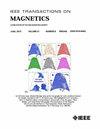电磁线圈自磁场、自力和自感的高效计算
IF 2.1
3区 工程技术
Q3 ENGINEERING, ELECTRICAL & ELECTRONIC
引用次数: 0
摘要
电磁线圈的设计可能需要评估几个难以用数值计算的量。这些量包括洛伦兹力,它可能是应力的限制因素;内部磁场,它与确定应力以及超导线圈是否接近淬火极限有关;以及电感,它决定了存储的磁能和动态。在计算一个线圈中的电流对另一个线圈的影响时,通常可以通过将线圈视为无限细来快速近似这些量。在计算线圈自身电流对线圈的影响(例如自力或自感)时,由于奇点的存在,评估非常困难;线圈不能被视为无限细,因为每个量在导体宽度为零时都会发散。在此,我们提出了新颖而稳健的方法,使用缩小维度的非矢量积分公式来评估这些量。这些公式是通过将磁矢量势的积分域划分为两个区域,在每个区域利用适当的近似值并以高纵横比展开而严格确定的。我们的计算公式显示,即使在低纵横比的情况下,我们的计算公式与完全有限厚度计算结果也有很好的一致性,无论是对环形磁场的分析,还是对恒星器聚变装置--螺旋对称实验(HSX)--的非平面线圈的数值计算,都是如此。由于这些公式的积分项会随着小半径变得无限细而形成精细结构,因此我们还开发了一种方法,通过对这一尖锐特征进行分析积分,以更高的效率评估自力和自感。我们用这种方法证明,只需 12 个网格点就能精确计算 HSX 线圈的自力。此外,我们还证明,与行业标准的有限元分析 (FEA) 软件相比,这种方法的计算速度显著提高:对于 HSX 线圈,使用这种方法计算磁场只需每点几毫秒的时间,而 FEA 软件需要一个小时才能对整个网格进行类似精度的评估。本文章由计算机程序翻译,如有差异,请以英文原文为准。
Efficient Calculation of the Self-Magnetic Field, Self-Force, and Self-Inductance for Electromagnetic Coils
The design of electromagnetic coils may require evaluation of several quantities that are challenging to compute numerically. These quantities include Lorentz forces, which may be a limiting factor due to stresses; the internal magnetic field, which is relevant for determining stress as well as a superconducting coil’s proximity to its quench limit; and the inductance, which determines stored magnetic energy and dynamics. When computing the effect on one coil due to the current in another, these quantities can often be approximated quickly by treating the coils as infinitesimally thin. When computing the effect on a coil due to its own current (e.g., self-force or self-inductance), evaluation is difficult due to the presence of a singularity; coils cannot be treated as infinitesimally thin as each quantity diverges at zero conductor width. Here, we present novel and well-behaved methods for evaluating these quantities using non-singular integral formulas of reduced dimensions. These formulas are determined rigorously by dividing the domain of integration of the magnetic vector potential into two regions, exploiting appropriate approximations in each region and expanding in a high aspect ratio. Our formulas show good agreement to full finite-thickness calculations even at low aspect ratio, both analytically for a torus and numerically for a non-planar coil of a stellarator fusion device, the helically symmetric experiment (HSX). Because the integrands of these formulas develop fine structure as the minor radius becomes infinitely thin, we also develop a method of evaluating the self-force and self-inductance with even greater efficiency by integrating this sharp feature analytically. We demonstrate with this method that the self-force can be accurately computed for the HSX coil with as few as 12 grid points. Additionally, we demonstrate that this method offers a significant speed-up compared to industry standard finite-element analysis (FEA) software: for the HSX coil, it is possible to compute the magnetic field in a fraction of a millisecond per point with this method, while FEAs require an order of an hour to evaluate across an entire mesh to a similar accuracy.
求助全文
通过发布文献求助,成功后即可免费获取论文全文。
去求助
来源期刊

IEEE Transactions on Magnetics
工程技术-工程:电子与电气
CiteScore
4.00
自引率
14.30%
发文量
565
审稿时长
4.1 months
期刊介绍:
Science and technology related to the basic physics and engineering of magnetism, magnetic materials, applied magnetics, magnetic devices, and magnetic data storage. The IEEE Transactions on Magnetics publishes scholarly articles of archival value as well as tutorial expositions and critical reviews of classical subjects and topics of current interest.
 求助内容:
求助内容: 应助结果提醒方式:
应助结果提醒方式:


